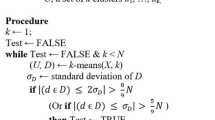Abstract
Noise clustering, as a robust clustering method, performs partitioning of data sets reducing errors caused by outliers. Noise clustering defines outliers in terms of a certain distance, which is called noise distance. The probability or membership degree of data points belonging to the noise cluster increases with their distance to regular clusters. The main purpose of noise clustering is to reduce the influence of outliers on the regular clusters. The emphasis is not put on exactly identifying outliers. However, in many applications outliers contain important information and their correct identification is crucial. In this paper we present a method to estimate the noise distance in noise clustering based on the preservation of the hypervolume of the feature space. Our examples will demonstrate the efficiency of this approach.
Similar content being viewed by others
References
Bezdek JC (1980) A convergence theorem for the fuzzy ISODATA clustering algorithms. IEEE Transactions on Pattern Analy Mach Intell 2:1–8
Dave RN (1991) Characterization and detection of noise in clustering. Pattern Recognit Lett 12:657–664
Dave RN, Krishnapuram R (1997) Robust clustering methods: a unified view. IEEE Trans Fuzzy Syst 5:270–293
Dave RN, Sumit S (1997) On generalizing the noise clustering algorithms. In: Proceedings of the 7th fuzzy systems association world congress (IFSA-97), vol 3, pp 205–210
Dave RN, Sumit S (1998) Generalized noise clustering as a robust fuzzy c-m-estimators model. In: 17th Annual conference of the north american fuzzy information processing society (NAFIPS-98). Pensacola Beach, Florida, pp 256–260
Estivill-Castro V, Yang J (2004) Fast and robust general purpose clustering algorithms. Data Mining Knowl Discovery 8:127–150
Gath I, Geva AB (1989) Unsupervised optimal fuzzy clustering. IEEE Trans Pattern Analy Mach Intell 11:773–781
Gustafson DE, Kessel WC (1979) Fuzzy clustering with a fuzzy covarianz matrix. In: Proceedings IEEE conference on decision and control, San Diego, pp 761–766
Hawkins D (1980) Identification of outliers. Chapman and Hall, London
Klawonn F (2004). Noise clustering with a fixed fraction of noise. In: Lotfi A, Garibaldi JM (eds). Applications and science in soft computing. Springer, Berlin Heidelberg New York, pp. 133–138
Klawonn F, Rehm F (2006) Clustering techniques for outlier detection. In: Wang J (ed) Encyclopedia of data warehousing and mining, idea group, Hershey, pp 180–183
Krishnapuram R, Keller JM (1993) A possibilistic approach to clustering. IEEE Trans Fuzzy Syst 1:98–110
Krishnapuram R, Keller JM (1996) The possibilistic c-means algorithm: insights and recommendations. IEEE Trans Fuzzy Syst 4:385–393
Santos-Pereira CM, Pires AM (2002). Detection of outliers in multivariate data: a method based on clustering and robust estimators. In: Härdle W, Rönz B (eds). Proceedings in computational statistics: 15th symposium held in Berlin. Physica-Verlag, Heidelberg, pp. 291–296
Windham MP (1981) Cluster validity for fuzzy clustering algorithms. Fuzzy Sets Syst 5:177–185
Author information
Authors and Affiliations
Corresponding author
Rights and permissions
About this article
Cite this article
Rehm, F., Klawonn, F. & Kruse, R. A Novel Approach to Noise Clustering for Outlier Detection. Soft Comput 11, 489–494 (2007). https://doi.org/10.1007/s00500-006-0112-4
Published:
Issue Date:
DOI: https://doi.org/10.1007/s00500-006-0112-4




